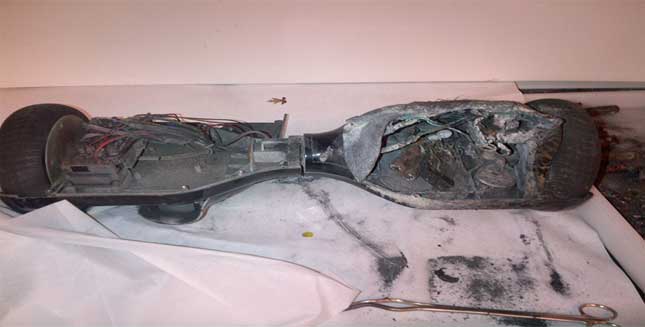
Product safety officials have received multiple complaints of hoverboards catching fire. Topping the holiday gift wish list of many youth this year is the much-envied hoverboard. If a child or teen you love is hoping to unwrap one soon, take note. Elliot F. Kaye, Chairman of the US Consumer Product Safety Commission, recently release a statement warning shoppers and families of the potential dangers of this popular toy – a move prompted by a rash of reports of hoverboards, also called smart boards or balance boards, catching fire. At the time of this writing, CPSC officials confirmed that the agency is investigating at least 10 cases of hoverboard-related blazes in nine states, including Florida.
Some boards caught fire during charging, while others caught fire during use. In one case that made headlines nationwide, a Louisiana home was destroyed after a hoverboard purchased from Fit Turbo on Amazon.com burst into flames while its lithium batteries were being charged. “Every consumer who is riding a hoverboard, who purchased one to give as a gift during the holidays, or who is thinking about buying one deserves to know if there is a safety defect,” Kaye said in a written statement released this week. “I have directed agency staff to work non-stop to find the root cause of the fire hazard, how much of a risk it might present, and to provide consumers with answers as soon as possible.” Engineers at the CPSC’s National Product Testing and Evaluation Center in Maryland are testing new and damaged boards, focusing on the configuration of the battery packs and compatibility with the chargers.
Though the fires are of top concern, Kaye also urges riders and parents to be aware of fall hazards as well. Dozens of hoverboard-caused fall injuries have been reported in recent months. The most serious among them include concussions, fractures, contusions, abrasions and internal organ injuries. Kaye says he’s most troubled by the fact that there are no set safety standards currently in place for hoverboards. “Strong safety standards protect consumers,” he said. “Retailers should always be asking their suppliers if there is an applicable safety standard in place before agreeing to sell those products. The absence of any standard should cause retailers to require extra proof of sound design manufacturing and quality control processes.” Kaye’s statement includes the following recommendations:
- Avoid buying the product at a location (like a mall kiosk) or on a website that does not have information about who is selling the product and how they can be contacted if there is a problem
- Do not charge a hoverboard overnight or while otherwise unattended.
- Charge and store hoverboards and chargers in an open dry area away from combustible items.
- Let your hoverboard cool down for at least an hour after riding before charging.
- If giving a hoverboard to someone for the holidays, leave it in its partially charged state. Do not take it out of the package to bring it to a full charge and then wrap it back up.
- Look for the mark of a certified national testing laboratory, though keep in mind that counterfeits may exist.
- Do not ride or allow children to ride hoverboards near vehicular traffic.
- Always wear safety gear including a helmet, knee and elbow pads and wrist guards for protection from falls
If you or your child suffer an injury caused by a defective hoverboard or other toy, get medical treatment and call 904-251-1111 to speak with an experienced product liability attorney with Jacksonville’s Harrell and Harrell.
